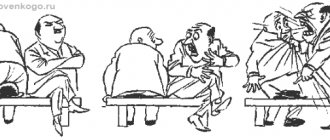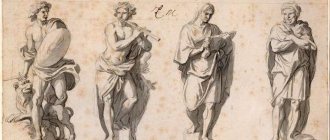The type of temperament is an innate feature of the human nervous system. Basically, it remains unchanged throughout life (not to be confused with character). Knowing the type of temperament, we can say about the speed of occurrence and intensity of an individual’s mental processes, the strength of his emotions, and these are not all the characteristics.
Each temperament has its own capabilities - find out which activity suits you
To determine your temperament type, take the test. The accuracy of the result depends on how honest you are with yourself. A brief description of each type of temperament is below the test. When two types of temperament are combined, the test does not give an interpretation, read it yourself. So let's get started...
What is temperament
Temperament is based on the type of higher nervous system. People (like animals) differ from each other from birth:
- by the strength of the processes of excitation and inhibition;
- the balance of these processes;
- mobility (changeability) of excitation and inhibition processes.
Taken together, this determines the endurance of nerve cells, that is, the endurance of the psyche.
Discovery of temperament
When excitation predominates over inhibition, conditioned reflexes are formed quickly and slowly subside, and when the ratio is reversed, conditioned reflexes are formed slowly and quickly fade away. These patterns were discovered by the domestic scientist Ivan Petrovich Pavlov.
This discovery made an invaluable contribution to the further development of psychology and pedagogy. Currently, there is no doubt that each person requires an individual approach in the process of upbringing, training or psychological correction.
Temperament and personality
Temperament is a set of innate mental properties. It serves as the basis for character formation. This is what is biological in a person.
At the same time, temperament is involved in the formation of personality. As a set of individual characteristics, it influences the dynamics and emotional side of human activity and behavior.
Depends on temperament:
- speed of occurrence of mental activity;
- stability of mental processes;
- mental tempo and rhythm;
- intensity of mental processes;
- direction of mental activity.
Anxiety, impulsiveness, emotionality, impressionability and other personality traits depend on temperament.
Temperament and character
Temperament is often confused with character. I propose to put an end to the differentiation of these issues once and for all.
- If character is a product of socialization, then temperament is an innate, unchangeable feature of an individual.
- You cannot change your temperament, but you can learn to manage it. Character can be changed.
- Temperamental traits can be masked by personality traits, making it difficult to determine what type of temperament a particular person belongs to.
Temperament and activity
Temperament provides an individual style of activity, that is, work methods characteristic of a particular person. So, for example, one child, when solving a problem, can sit idle for a long time, think about it and immediately write down the result, while another will immediately start writing something down, sketching it out, crossing it out, and after a while will isolate the main thing from it. Same result - different ways to achieve it.
Traits of a choleric child
Choleric children often become the center around which the whole family revolves
.
They can be capricious until they get what they want, and believe that everything should be just the way they want. At the same time, such children are very grateful to loved ones even for small surprises and signs of attention. If choleric children are happy with everything, they become very affectionate, sweet and responsive
. In adolescence, they are characterized by hyperactive manifestations of emotions - a teenager-hooligan with aggressive behavior is a classic type of choleric person.
Properties of temperament
Each temperament has certain properties.
Sensitivity
This implies the necessary minimum force of external stimulation to initiate reactions in the individual’s psyche. In addition, sensitivity involves assessing the speed of this reaction.
Reactivity
Determines the strength and speed of response to an unexpected stimulus, that is, these are involuntary reactions to light, loud sound, unexpected action. A person’s distractibility and ability to concentrate depend on reactivity.
Activity (passivity)
The degree of influence of temperament on the stimuli surrounding it. Simply put, this is the speed with which a person can influence the circumstances and obstacles that prevent him from achieving his goal. Activity stems from the relationship between a person’s orientation to the outside world (previous point) and focus on one’s goals, desires, needs, and beliefs.
Plasticity (rigidity)
This characterizes the speed of a person’s adaptation to changes in the external environment. Plasticity is a good ability to adapt, rigidity is the impossibility, difficulty in changing beliefs, views, interests.
Extraversion (introversion)
A person’s orientation towards the external or internal world (direction of vital energy). The second interpretation: a person’s orientation towards the external present (extroversion) or the figurative past or future (introversion).
Excitability of emotions
Determines the speed of emotional response to a minimal external stimulus (the minimal force to which an emotional reaction occurs).
Rate of reactions
This is the speed of mental processes and reactions (duration): speed of reaction, rate of speech, speed of mind.
The properties of temperament manifest themselves depending on the situation and specific conditions. Therefore, people of different temperaments can act completely differently in identical situations, but in the same way under different conditions.
Predecessor tests
The first temperament questionnaire, the MMQ, was introduced in 1947. It used a single scale as a diagnostic - “neuroticism”. It contained 40 statements with which the person agreed or disagreed. In the course of further research on large samples, the scientist determined that the answers given to the questions of this questionnaire made it possible to identify another measurement scale - “extraversion-introversion”.
Nine years after the first test was published, Eysenck proposed a second personality questionnaire, the MPI, consisting of 48 questions.
During the studies, discrepancies were revealed between the author’s theoretical statements and the data, so scientists and collaborators continued to search for new possibilities that would allow them to determine the type of temperament in accordance with the proposed scales - “neuroticism”, “extraversion and introversion”.
Temperament types
In psychology, it is customary to distinguish 4 types of temperament, or types of the nervous system (according to its properties). But at the same time, there are several typologies.
According to the processes of excitation-inhibition
Sanguine
This is a strong, agile and balanced type. It is characterized by a rapid process of excitation and its rapid change to inhibition.
- A person with this type of psyche is characterized by love of life, activity, sociability, and responsiveness.
- He is not prone to worry, easily adapts to new conditions, and strives for leadership.
- A sanguine person is successful in work, friendship and love.
- He easily switches from one activity to another and changes hobbies with the same ease.
- However, without external stimuli, he begins to get bored and becomes lethargic.
- He is always distinguished by some superficiality in his perception of people and phenomena, which sometimes causes difficulties in interpersonal relationships. But a sanguine person can easily cope with them.
- The feelings and emotions of a sanguine person are bright, but unstable.
- Laughs often and loudly, but gets angry over trifles.
- Resourceful and agile, can manage emotions.
- As a rule, he has fast speech.
Phlegmatic person
This is a strong, inert and balanced type. Conditioned reflexes are developed slowly, but then become very stable.
- A person with this type is always passive, cautious and reasonable. Sometimes it comes to the point of “tediousness and nausea.”
- At the same time, he is peaceful and friendly.
- It is easy to manage and control its actions.
- A phlegmatic person is not emotional or sensitive, but you can always rely on him.
- He has great perseverance, self-control, patience, high efficiency, but is slow.
- Stable in relationships, not prone to change.
- Provides good resistance to negative long-term stimuli from the outside. The self-control and composure characteristic of a phlegmatic person sometimes turns into indifference to oneself, others, and work.
Choleric
Strong, agile and unbalanced type. Excitation processes prevail over inhibition processes.
- Easily excitable, aggressive and restless type.
- Choleric is characterized by variability, inconstancy, impulsiveness, activity and optimism.
- Along with great vital energy, one can distinguish lack of restraint and abruptness of movements and actions, loudness, low level of self-control, impatience and frequent sudden mood swings.
- A choleric person is distinguished by expressive facial expressions, fast speech and rapid movements.
Melancholic
Weak, inert (or mobile) and unbalanced type.
- Characterized by a pessimistic attitude, a tendency to anxiety and reasoning.
- He is reserved and uncommunicative, easily vulnerable, emotional, and highly sensitive.
- Shows little resistance to external stimuli, is inhibited and passive.
- A melancholic person, as a rule, is not self-confident, timid, timid, and touchy.
- But his inner world and associative thinking are very reeking.
- A melancholic person is not distinguished by expressive facial expressions and movements, and does not adapt well to new conditions.
- Characterized by quiet speech, poor attention and fatigue.
Galen's typology
The Roman philosopher and physician Galen also identified 4 types of temperament, but he focused on feelings. This typology does not contradict the others, on the contrary, it complements them and, in my opinion, is of particular interest from the position of everyday psychology.
Sanguine
Pliable to feelings, but quickly cools down. Strives for pleasure, a trusting and gullible person.
Choleric
A man of passions. He is characterized by pride, vindictiveness and ambition.
Phlegmatic person
Resistant to the influences of feelings. Doesn't complain or be indignant, gets irritated with great difficulty.
Melancholic
Sadness is his main characteristic. Any suffering seems unbearable, and desires are saturated with sadness. He often thinks that he is being neglected and is offended by small things.
According to the ratio of signaling systems
The signal system is usually called a set of mental processes responsible for perception, analysis of information and response. A person has two such systems:
- the first signaling system (the assimilation of information through the activity of the cerebral cortex, through receptors);
- second signaling system (everything related to speech and words).
Based on the relationship between signaling systems, 3 types of people (temperaments) can be distinguished.
Artist
The first signaling system predominates.
Thinker
The second signaling system predominates.
Mixed type
Approximately equal influence of both systems.
This classification is considered relative, since the severity of the systems depends on the specific type of activity.
Constitutional theory of E. Kretschmer
The German psychiatrist and psychologist Kretschmer compiled a typology of temperaments depending on a person’s physique.
Schizothymic (asthenic type)
A weak-willed and withdrawn type, prone to emotional swings. A gentleman and a dreamer, an idealist. At the same time, the schizothymic person is stubborn and selfish, prone to abstract thinking.
Cyclothymic (pyknic type)
Like the first type, it is distinguished by emotional waves. He is a cheerful chatterbox and humorist, a realist, and a good conversationalist.
Ixothymic (athletic type)
He is not flexible in thought, calm and unimpressive. His gestures and facial expressions are restrained. Ixothymic has difficulty adapting to new conditions.
By observing a person’s behavior and assessing his physique, we can guess what type of temperament he belongs to. This will be useful for establishing contact.
Sanguine
Cheerful and faulty optimists who are unable to sit in one place. They are constantly on the move. Such people:
- active in absolutely all spheres of life, but without trying to dictate their own like choleric people;
- excessive excitability with a low inhibition threshold, leading to a somewhat illusory view of the world;
- the ability to lead a crowd and find a compromise in absolutely any difficult situation;
- hyperactivity, manifested in the desire to make one’s life interesting by traveling and discovering something new.
Among people with the sanguine temperament type
many musicians, actors, artists. Monotonous and monotonous work puts them into a depressive state.
They may seem slightly absent-minded because they easily remember some funny incidents, but forget about the birthdays of even those closest to them and other important things. The reason is that they can only focus on what piques their interest, which is usually something new.
The emotions of a sanguine person are sincere, so he never hides his sympathy from the people he likes. He always has many friends whom he is ready to help, but in order to build a strong family, he is often hindered by an excessive thirst for communication.
The disadvantages of this temperament are:
- inconstancy, when a job started, if it turns out to be boring, is not completed;
- reassessment of oneself and one’s own capabilities;
- mood swings.
To become more reliable in routine matters, which play an important role in everyone’s life, psychologists recommend that sanguine people work on willpower, and also pay attention not only to bright and admirable things, but also to little things.
Definition of temperament and brief instructions for interaction
You can guess the temperament of your interlocutor based on observations of him, but this is an ambiguous and complex method. Currently, there are many accurate methods for diagnosis and self-diagnosis.
- Eysenck test. The most popular technique that determines the type of temperament on two scales: stable and unstable, introversion and extroversion. Allows you to determine the severity of each type and the nature of mixed temperament. Suitable for self-diagnosis.
- Another popular technique is the Belov formula. This questionnaire is smaller than the previous one, characterizes only temperaments (without scales), but also gives the value and percentage of each type in a person.
Determining temperament is the first stage, but far from the main one. Much more important is the ability to understand the person opposite and interact with him competently, taking into account his innate characteristics.
Interaction with a choleric person
- Remember that not everything that a choleric person says is really true. It's just that his speech is ahead of his thoughts.
- The conditions and specific emotions of the choleric person at the moment are to blame. Under other conditions, he may say the opposite.
- If, in a fit of anger, a choleric person said something unpleasant, this does not mean at all that he really has a bad opinion of you.
- In a relationship with a choleric person, you should be lenient, not take everything to heart, take into account situations that are individually dangerous for him and avoid them.
- Remember that choleric people do not get hung up on quarrels and conflicts (especially random and momentary ones), they actually forget them and never return to discussions.
- Do not put pressure on the choleric person, especially in work matters.
- Instead, give yourself a break and provide support.
Interaction with a sanguine person
- Communication is the air for a sanguine person. It’s worth getting used to and accepting the fact that there are always a lot of people around him. People are drawn to a sanguine person, and he is drawn to them.
- It seems that it is impossible to argue with him, but this is not so. Despite their optimism and friendliness, sanguine people are rich in “cockroaches”.
- Due to the superficiality of their judgments, sanguine people often make the wrong conclusions. But they cannot be superficial. Remember this and give them a second chance.
- It is difficult for a sanguine person to admit his mistakes; he does not know how to do this. That's why you shouldn't wait for it.
- Face - instructions for a sanguine person. The case when everything is really written on the face. Be observant, and the facial expressions of a sanguine person will tell you everything: what a person thinks, what is pleasant to him, what is unpleasant, and so on.
- Constantly feed it with impressions and events. With monotony and the same type of sensations, a sanguine person gets bored and may leave the relationship. But they become attached to those who always give them new emotions, sensations and conditions of reality for a long time.
- Sanguine people like it when they are asked for advice or asked for their opinion.
- Reason with him, solve problems, make plans.
- Don't neglect extreme sports and adrenaline.
Interaction with a melancholic person
- Avoid loud and sharp sounds and screams.
- Do not resort to a negative assessment of the melancholic person and what is dear to him.
- Avoid criticism, punishment, and reproach. If necessary, choose soft, non-accusatory forms.
- Getting close to a melancholic person is simple - you need to evoke self-pity, tell a sad story, evoke and show sympathy.
- Avoid extreme situations and entertainment.
- Preference should be given to warm, sincere conversations.
- When it comes to films, a melancholic person will prefer drama to horror and thrillers.
- Never say “urgently”, don’t push, don’t demand, don’t order. This drives the melancholic person into a stupor, he begins to frantically make the wrong movements, panics, and does not understand anything.
- In detailed work that requires focus and attention, a melancholic person is an excellent candidate.
- A melancholic person should be introduced to new people gradually and carefully. Don’t “throw him into the hole with all his might.”
- Melancholic people have well-developed intuition, they rarely make mistakes.
Interaction with a phlegmatic person
- You can recognize a phlegmatic person only through communication, but you need to pull everything out with pincers.
- Phlegmatic people are conservatives, so you shouldn’t demand that they quickly get used to and accept something new.
- In new situations or after a non-standard proposal, give the phlegmatic person enough time to think.
- Don’t expect efficiency and speed in other matters either. A person interacting with a phlegmatic person must be able to wait and be patient.
- Don't expect sympathy or other emotional responses, especially momentarily.
- But this does not mean that they are completely indifferent and do not experience emotions. A phlegmatic person may worry about you, but it is difficult for him to squeeze out words or gestures; he would rather silently do something useful for you.
- By the way, they expect the same sympathy from others: support in deeds, not in words.
- If you want to win the favor of a phlegmatic person, then you need to be realistic, avoid fantasies, demonstrate logic and prudence, equanimity and rationality.
- Entertainment, holidays, creativity, and conversations do not attract a phlegmatic person. The matter is important to him.
- The second thing that attracts me is clear, practical, understandable speech. It is recommended to avoid imagery and slang when communicating with a phlegmatic person.
- It is better to write out all requests or tasks for a phlegmatic person on paper, writing them down as clear instructions.
There are no bad or good temperaments; you can find a common language with any person, however, provided that your temperaments coincide.
- For example, a choleric person is incompatible with a sanguine person. These are two leaders.
- Neither a choleric person nor a melancholic person can get along. One does not intentionally, but constantly offends, the other is offensive in itself.
- Choleric and phlegmatic are the best option.
- A sanguine person and a phlegmatic person will often quarrel, but at the same time they can resolve these conflicts. However, dissatisfaction with each other will increase.
- A sanguine person will be suited to his opposite - a melancholic person. Moreover, it is ideal if the sanguine person is a man.
Interesting Facts
I would like to introduce you, dear friends, to some interesting facts about temperaments.
- Happy married couples come from people with different temperaments.
- For friendship, on the contrary, it is important that the temperaments are the same (except for choleric people).
- Phlegmatic people are universal partners in any relationship, but not with phlegmatic people.
- Sanguine people make excellent leaders. A choleric or phlegmatic person is completely unsuitable for such a role.
- Job descriptions and other information should be presented in different forms for each temperament type.
- The phlegmatic person is slow to respond to questions.
- A sanguine person because of haste, and a choleric person because of impetuosity is prone to rash and incorrect answers.
- You need to ask a melancholic person gently and kindly.
- The specificity of people’s speech and the nature of information transfer depend on temperament. We can present the same picture from words of different types in completely different ways.
It is worth noting that in practice pure types of temperament are rarely found; mixed ones are more common. This makes it even more difficult to determine temperament and choose an approach to interacting with a person.
In conclusion, I would like to note that the compatibility of people in temperament, or at least understanding the characteristics of another person, is important for any area of relationships (family, professional, friendly). We often hear the phrase “We didn’t get along in character,” but in fact it would be more correct to say “We didn’t get along in temperament.” And this really can happen.
Phlegmatic person
Balanced people who think through absolutely every step. They have an analytical mind and always soberly assess the situation, rarely giving in to emotions and demonstrating their temper even in difficult situations.
Characteristics:
- rarely lose their temper and almost never show joy or activity;
- look closely at people for a long time before making contact;
- do not tolerate a change of environment and prefer the comfort of home to active entertainment;
- painstaking and assiduous, can remember a huge amount of information;
- closed, secretive, difficult to make contact, but they do everything to win the favor of the person they like.
Since by nature they do not get along very well with people, they value their friends and usually such relationships last a lifetime. They get married late and carefully search for their soulmate.
The main disadvantages of the phlegmatic temperament type
are:
- poor receptivity and lack of initiative even in the presence of strong external stimuli;
- stinginess with emotions, slow involvement in work, poor contact with other people;
- difficulty in adapting when the situation changes.
From a psychological point of view, this is the most balanced individual of all substances, but in order for everything to work out in life, such people need to fight lethargy and laziness.
Improved techniques
In 1963, the EPI (Eysenck Personality Inventory) questionnaire was proposed - a new technique, the questions of which, in the amount of 48 pieces, are intended to diagnose the “neuroticism” and “extraversion-introversion” scales, and 9 add up to the “lie” scale - with its help it is determined a person’s desire to “embellish” himself (a total of 57 points were identified).
The EPI methodology was developed based on responses received from more than 30 thousand people, which is several orders of magnitude greater than the number that was involved in the creation of MMQ and MPI.
The test uses two versions with different questions, but identical in form and meaning (to be used twice).
Six years later, Hans and Sibylle Eysenck offer the EPQ, a personality questionnaire that diagnoses not only the previous two described scales and the “lie” scale, but also psychoticism. Its high level is associated with the severity of special conditions in which the presence of inadequate mental reactions (psychosis) is possible. The test involves passing 101 questions.
The name of Eysenck is also known due to the fact that he proposed a method for identifying self-assessment of mental states, during which the presence of a prevailing psychotype is determined - frustration, anxiety, aggressiveness and rigidity.
Currently, the EPQ is not very popular, and not only because the previous test includes 57 questions - almost half as many as the present one. Many foreign researchers argue that the psychoticism scale cannot have a scientific basis, and the results obtained during experiments are often contradictory.











